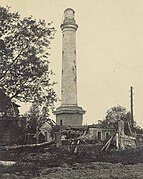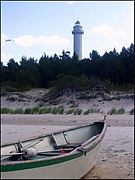Miķeļtornis lighthouse
| Miķeļbāka lighthouse Miķeļtornis (Michelsturm) |
||
|---|---|---|
| 2000 | ||
| Place: | Miķeļtornis ( German pissing ) | |
| Location: |
|
|
| Geographical location: | 57 ° 36 ′ 0 ″ N , 21 ° 58 ′ 30 ″ E | |
| Height of tower base: | 3 m above sea level HN | |
| Fire carrier height : | 56 m | |
| Fire height : | 59 m | |
|
|
||
| Identifier : | Fl (2) W. 6s 87 ° -251 ° |
|
| Scope knows: | 14 nm (25.9 km ) | |
| Optics: | Fresnel lens | |
| Operating mode: | Incandescent light | |
| Function: | Sea fire | |
| Construction time: | 1885 1957 |
|
| International ordinal number: | C3476 ARLHS : LAT-010, NGA : 12196, Latvia- #: UZ-470 |
|
The Latvian lighthouse Miķeļtornis Latvian Miķeļbāka , formerly German "Michelsturm", is the highest lighthouse in the entire Baltic region at 62 meters . It is located in the village of Miķeļtornis ( German pissing ) , municipality of Tārgale, Ventspils region and marks the St. Michael or Mikhailovskaya sandbank. The passage of the Irbenstrasse is dangerous here because of the shallows, currents and numerous shipwrecks.
story
The first lighthouse was built in 1881. The construction process was difficult because of the swampy soil and was not completed until 1884. The round brick building , which stood on a 14.6 meter high rectangular stone foundation, was already at that time the tallest lighthouse in the Baltic States with a height of 51.8 meters. The diameter of the tower was five meters with a wall thickness of one meter. The total weight of the structure was 3,200 tons. The lighthouse was first put into operation on August 15, 1885, as one of the first in Tsarist Russia to be electric. There was a generator house next to the tower . In winter, an oil-fired high-intensity lamp was used instead of the electric light source. The first cracks appeared in the tower as early as 1895. Major repairs were carried out in 1896, 1901 and 1902, but they did not improve the situation much.
First World War
During the First World War in 1915, the lighting and power plant equipment was dismantled. The German troops occupying the area needed a working lighthouse and installed an AGA - acetylene burner (AGA-Fyren) as a light source on it. During the war, the tower received twelve hits from artillery shells, which made its condition critical.
Latvian Period (1918-1940)
In strong winds, the tower began to sway and threatened to collapse. Therefore, a special committee formed in September 1929 decided to demolish the old lighthouse and build a new one. On July 3, 1932 at 4:30 p.m., the upper part of the lighthouse collapsed and the lower part was partially destroyed. As a temporary solution, a 19 meter high wooden lighthouse was built in July 1932. Construction of the new reinforced concrete lighthouse began on August 7, 1933, was suspended on October 5 and continued on April 6 of the following year. This lighthouse was built on the old foundation; it was a 32 meter high cylindrical tower on a five meter high hexagonal base. From the outside, the structure was reinforced with eight 14-meter-long buttresses. The total height of the lighthouse was 53 meters. On September 26, 1934 the new lighthouse was put into operation, which was no longer electrically fired, but was still equipped with a Swedish AGA lighting device (acetylene burner with a gas pressure device that regularly reduced the light to a minimum). The lighthouse had a 1.76 meter high Fresnel lens and a sector light that appeared green or white depending on the sector at sea.
Soviet era
In 1941 the retreating Red Army troops blew up this lighthouse. In 1946 a temporary wooden lighthouse with a height of 30 meters was installed. The current concrete tower was designed by the engineer J. Holands and built in 1957, as evidenced by the inscription above the entrance door. It has a height of 56 meters. An EVM-930 electric searchlight was used. In 1986 the lighthouse was renovated.
Current
293 steps lead to the top of the tower, from where there is a view of the surrounding Baltic coast and, if the visibility is good, over the sea to the Estonian lighthouse Sõrve tuletorn on the island of Saaremaa , 35 km away . Initially open to visitors, the tower was closed in 2019 due to its poor condition. Also on the bank, a few hundred meters east of the lighthouse, is an old nautophone mast .
See also
Web links
- Mikelbaka. In: Leuchtturm-anke.de. Retrieved August 28, 2020 .
- Online List of Lights -> C3476 Miķeļbāka. In: listoflights.org. Retrieved August 28, 2020 .
- Miķeltornis (Miķelbāka, Michailowsky) near Pissen, Latvia. In: Leuchtturm-web.de. Retrieved August 29, 2020 .
- Lauku celotajs: The Michel Tower . Retrieved August 29, 2020 .
- Latvian beacon directory. Login as a guest required! In: ANONSCADA. 2020, accessed on August 30, 2020 (English).
- ARLHS World List of Lights (WLOL). List of the world's lighthouses by the Amateur Radio Lighthouse Society. In: ARLHS .arlhs.com. Accessed August 31, 2020 .
- Russ Rowlett: Lighthouses of Western Latvia. University of North Carolina, April 25, 2005, accessed August 28, 2020 .
- Latvijas Jūras administrācija: List of Aids to Navigation in te Waters of the Republic of Latvia. (PDF) In: Latvijas Jūras administrācija Hidrogrāfijas dienests. Hidrogrāfijas dienests, 2009, accessed September 1, 2020 .
- Miķeļbākas celtniecība. In: Zudusī Latvija. Retrieved September 25, 2020 (Latvian).
- Три маяка за один день. Three lighthouses in one day. In: grumblerr.livejournal.com. August 25, 2013, accessed September 28, 2020 (ri).
- Размышлn: Мысли смертников. Thoughts on Death Row. In: newkamikaze.com. August 6, 2020, accessed September 28, 2020 (Russian).
Individual evidence
- ↑ Sunken submarine found. In: Salzburger Volksblatt , June 12, 1933, p. 5 (online at ANNO ).
- ↑ Erich Hartmann: lighting beacons. In: deutsche-leuchtfeuer.de. October 31, 2008, accessed September 28, 2020 .






